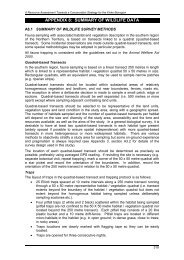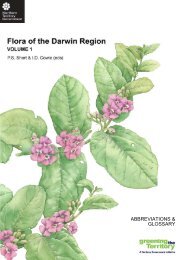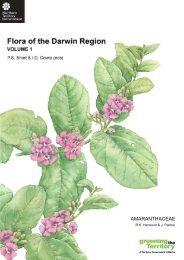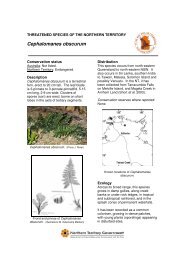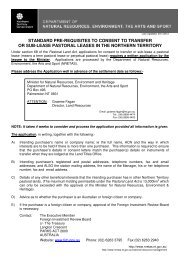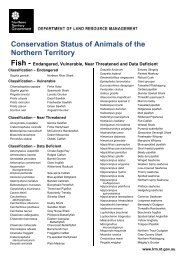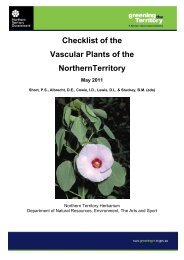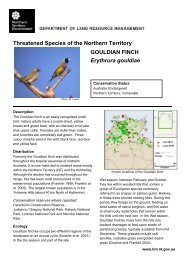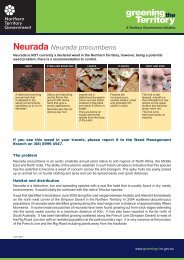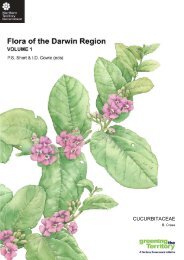DILLENIACEAE - Department of Land Resource Management ...
DILLENIACEAE - Department of Land Resource Management ...
DILLENIACEAE - Department of Land Resource Management ...
You also want an ePaper? Increase the reach of your titles
YUMPU automatically turns print PDFs into web optimized ePapers that Google loves.
<strong>DILLENIACEAE</strong><br />
R.A. Kerrigan, L.A. Craven & C.R. Dunlop
National Library <strong>of</strong> Australia<br />
Cataloguing-in-publication entry (PDF):<br />
Flora <strong>of</strong> the Darwin Region Volume 1<br />
ISBN: 9781921519949 (PDF)<br />
Series: Northern Territory Botanical Bulletin No. 37<br />
Notes: Includes bibliographical references and<br />
index.<br />
Subjects: Botany – Northern Territory – Darwin<br />
region – Plants – Identification<br />
Other Authors/Contributors: Short, P.S.,<br />
Cowie, I.D., Northern Territory <strong>Department</strong><br />
<strong>of</strong> Natural <strong>Resource</strong>s, Environment, the Arts<br />
and Sport.<br />
Dewey Number: 581.994295<br />
ISSN: 0314-1810<br />
Date <strong>of</strong> Publication: March 2011<br />
Cover: Helicteres procumbens (Benth.) Cowie, ined.<br />
Cover Artist: R. Walter<br />
Editors: P.S. Short and I.D. Cowie<br />
Illustrations: M. Osterkamp<br />
Typesetting: D. Bisa and M. Voukalis<br />
Photographic Editor: B.M. Stuckey<br />
Authors contributing to this publication:<br />
D.E. Albrecht<br />
Northern Territory Herbarium, <strong>Department</strong> <strong>of</strong><br />
Natural <strong>Resource</strong>s, Environment, the Arts and<br />
Sport, P.O. Box 1120, Alice Springs, N.T. 0871,<br />
Australia<br />
R.M. Barker<br />
State Herbarium <strong>of</strong> South Australia, Plant<br />
Biodiversity Centre, P.O. Box 2732, Kent Town,<br />
S.A. 5071, Australia<br />
I.D. Cowie; B. Crase * ; D.J. Dixon *; C.R. Dunlop *;<br />
R.K. Harwood *; R.A. Kerrigan *; G.J. Leach *;<br />
C. Mangion *; P.S. Short; G.M. Wightman *<br />
Northern Territory Herbarium, <strong>Department</strong> <strong>of</strong><br />
Natural <strong>Resource</strong>s, Environment the Arts and<br />
This book is copyright. Apart from any fair dealing<br />
for the purpose <strong>of</strong> private study, research, criticism<br />
or review, as permitted under the Copyright Act, no<br />
part <strong>of</strong> this publication may be produced by any<br />
process whatsoever without the written permission<br />
<strong>of</strong> the publisher.<br />
© Northern Territory Government<br />
Publisher:<br />
Northern Territory Herbarium<br />
<strong>Department</strong> <strong>of</strong> Natural <strong>Resource</strong>s,<br />
Environment, the Arts and Sport<br />
P.O. Box 496<br />
Palmerston, N.T. 0831, Australia<br />
Sport, P.O. Box 496, Palmerston, N.T. 0831,<br />
Australia<br />
L.A. Craven<br />
Australian National Herbarium, Centre for<br />
Plant, Biodiversity Research, G.P.O. Box 1600,<br />
Canberra, A.C.T. 2601, Australia<br />
L.L. Forman† (deceased)<br />
Royal Botanic Gardens, Kew, Richmond,<br />
Surrey, TW9 3AB, UK<br />
B. Jackes<br />
James Cook University Herbarium, School <strong>of</strong><br />
Marine and Tropical Biology, James Cook<br />
University, Townsville, Qld 4811, Australia<br />
L. Jessup<br />
Queensland Herbarium Mt Coot-tha Road,<br />
Toowong, Qld 4066, Australia<br />
J. Palmer<br />
Australian National Herbarium, G.P.O. Box<br />
1600, Canberra, A.C.T. 2601, Australia<br />
*Former employee NT Herbarium<br />
Suggested citation for this article:<br />
Kerrigan, R.A., Craven, L.A. & Dunlop, C.R.<br />
(2011). Dilleniaceae. In Short, P.S. & Cowie, I.D.<br />
(eds), Flora <strong>of</strong> the Darwin Region. (Northern<br />
Territory Herbarium, <strong>Department</strong> <strong>of</strong> Natural<br />
<strong>Resource</strong>s, Environment, the Arts and Sport).<br />
Vol. 1, pp. 1–19.<br />
http://www.nt.gov.au/nreta/wildlife/plants_<br />
herbarium/index.html
<strong>DILLENIACEAE</strong><br />
R.A. Kerrigan, L.A. Craven & C.R. Dunlop<br />
Evergreen trees, shrubs, subshrubs and lianes. Stipules present or absent. Leaves simple, usually alternate,<br />
rarely much reduced and scale-like. Inflorescences various, terminal, axillary or ramiflorous, solitary or<br />
cymose, paniculate, racemose or in fascicles or thyrses. Flowers bisexual, rarely unisexual, hypogynous,<br />
perianth actinomorphic. Sepals (3–) 5 (–20), imbricate, persistent; petals (2–) 5, imbricate, <strong>of</strong>ten crumpled<br />
in bud, deciduous, rarely persistent. Stamens <strong>of</strong>ten numerous or as few as 1, sometimes asymmetrically<br />
placed; anthers tetrasporangiate and dithecal, opening by longitudinal slits or distal pores. Gynoecium <strong>of</strong><br />
1–several (–5) distinct carpels in 1 or 2 whorls or rarely connate to form a plurilocular ovary with<br />
distinct styles; styles <strong>of</strong>ten capitate; ovules 1–many per carpel. Fruit dry and dehiscent or sometimes<br />
(Dillenia) indehiscent and enclosed in the more or less fleshy calyx. Seeds <strong>of</strong>ten arillate.<br />
Consists <strong>of</strong> perhaps ten genera and c. 500 species and has a mostly Gondwanic distribution. Three<br />
genera are accepted as occurring in Australia, i.e. Dillenia, Hibbertia and Tetracera (two species, tropical<br />
Qld), with species previously placed in Pachynema recently transferred to Hibbertia.<br />
Taxonomic references: Hoogland (1949); Cronquist (1981); Wheeler (1992); Kubitzki (2004); Horn<br />
(2007, 2009).<br />
1 Leaves mostly 8 cm long or longer; tree or large leafy shrub................................. Dillenia<br />
1: Leaves mostly less than 8 cm long or absent; shrub or subshrub ......................... Hibbertia<br />
DILLENIA L.<br />
Trees or shrubs. Leaves, simple and spirally arranged. Petiole usually with broad wings, amplexicaul in the<br />
young leaf and then enclosing and protecting the terminal bud. Inflorescence a raceme or solitary,<br />
terminal, leaf-opposed, or axillary, in some species cauline or ramiflorous. Bracts and bracteoles present.<br />
Flowers actinomorphic. Sepals (4) 5 (6), in a few species more. Petals (4) 5 (6), in some species absent,<br />
usually obovate with rounded apex, yellow or white, rarely reddish. Stamens numerous, staminodes<br />
sometimes present. Carpels 4–20, connate along central part <strong>of</strong> the receptacle; styles filamentous or<br />
linear, more or less spreading; stigma indistinct in most species; ovules 6 to c. 60. Fruit either dehiscent<br />
or indehiscent, enclosed by the enlarged sepals. Seeds arillate or exarillate.<br />
A genus <strong>of</strong> c. 110 species, recorded from Madagascar, the slopes <strong>of</strong> the Himalayas, Malesia, Australia<br />
and Fiji. One species, D. alata, is native to Australia and one, D. suffruticosa, appears to be occasionally<br />
naturalised in the D.R.<br />
Some species are used for their edible fruits and medicinal applications or are cultivated as ornamentals.<br />
Dillenia indica (Elephant Apple), not treated here, is also grown in Darwin gardens. It is an evergreen<br />
with distinctive, finely serrate, penniveined leaves; the flowers are white and the large fruit are enclosed<br />
in enlarged, slightly fleshy persistent sepals which are c. 12 cm long and 10 cm wide.<br />
Taxonomic references: Hoogland (1952); Hyland et al. (2002).<br />
1 Wings on petiole 2–6 mm wide, constricting rather than dilating<br />
towards apex ................................................................................................................. D. alata<br />
1: Wings on petiole to 15 mm wide, dilating towards the apex ................................ *D. suffruticosa<br />
D. alata (R. Br. ex DC.) Martelli<br />
Tree to 20 m tall, trunk to 60 cm diam., with<br />
reddish-brown bark peeling <strong>of</strong>f in thin papery<br />
flakes. Petiole (1.6) 2.5–4 cm long, with 2–6 mm<br />
wide wings; wings <strong>of</strong> about even width<br />
throughout their length, constricting rather than<br />
dilating towards apex. Lamina ovate to elliptic,<br />
occasionally oblong to obovate, (5) 8–28 cm long,<br />
(3) 5–15 cm wide, glabrous, slightly recurved<br />
margin, apex rounded. Inflorescence a terminal or<br />
leaf-opposed raceme, 2–4-flowered. Sepals 5, outer<br />
2 orbicular, 1.3 cm diam., inner 3 elliptic to ovate,<br />
to 2 cm long, to 1.5 cm wide. Petals 5, obovate,<br />
25–40 mm long, 19–25 mm wide, yellow. Stamens<br />
FDRV1 March 2011
2<br />
in 2 distinct groups, the outer ones c. 100, 7–<br />
8 mm long, straight in bud, the inner ones c. 18,<br />
11–13 mm long, with their apices reflexed in bud.<br />
Carpels 6–8, c. 10 mm long, 4 mm wide, deep<br />
crimson, with red styles, c. 14 mm long; ovules<br />
c. 8 per carpel. Fruit dehiscent, carpels 1–3-seeded.<br />
Seeds obovoid, c. 4 mm long, 3 mm wide, black,<br />
with reticulate surface, enclosed by waxy-white<br />
membranous aril. Flowering: June–Feb. Fruiting:<br />
Sept.–Oct.<br />
Fig. 1. (Dunlop 7431); Pl. 1 (unvouchered).<br />
Australia (N.T., Qld) and New Guinea. In the<br />
N.T. found in central and north-east Arnhem<br />
<strong>Land</strong>. Grows in rainforest but frequently occurs<br />
in wet situations in other types <strong>of</strong> forest,<br />
particularly on the coastal lowlands.<br />
*D. suffruticosa (Griff.) Martelli<br />
Shrub or tree to 10 m tall. Petiole 2–6 cm long,<br />
1.5 cm wide, the wings dilating upwards. Lamina<br />
elliptic to obovate, 13–25 cm long, 8–12 cm wide,<br />
margin entire to toothed, upper surface glabrous<br />
<strong>DILLENIACEAE</strong><br />
HIBBERTIA Andrews<br />
or sometimes slightly woolly on young leaves,<br />
lower surface slightly to densely woolly on the<br />
lateral nerves and on both sides <strong>of</strong> the central<br />
nerve. Inflorescence a terminal raceme or leafopposed,<br />
c. 5–12-flowered. Sepals 5, 15–22 mm<br />
long, 8–12 mm wide. Petals 5, obovate, 40–50 mm<br />
long, 25–30 mm wide, bright yellow. Stamens<br />
c. 175, the outer ones 8 mm long and straight in<br />
bud, the inner ones 13 mm long and with their<br />
apices reflexed in bud. Staminodes c. 100, 6 mm<br />
long. Carpels 5–8, usually 7, c. 5 mm long, 2 mm<br />
wide; styles yellowish-white, c. 1 cm long. Ovules<br />
7–10 per carpel. Fruit dehiscent. Seeds obovoid,<br />
c. 3 mm long, 2 mm wide, brown or black, with a<br />
membranaceous scarlet aril. Flowering & fruiting:<br />
probably throughout the year.<br />
Fig. 1 (Risler 2512).<br />
Native to Malesia and commonly cultivated<br />
elsewhere as an ornamental. In the D.R. there<br />
is some evidence that the species is naturalised<br />
in the rural area in wet situations.<br />
Shrubs, subshrubs or rarely vines, sometimes rhizomatous; stems in some species photosynthetic and<br />
these <strong>of</strong>ten flattened and sometimes dimorphic. Leaves spirally arranged, simple, entire or toothed,<br />
sometimes readily dehiscent or reduced to scales; stipules absent. Inflorescence usually solitary and axillary,<br />
or terminal. Sepals 5, <strong>of</strong>ten dimorphic, with an outer whorl <strong>of</strong> 2 sepals, an inner whorl <strong>of</strong> 2 sepals and a<br />
variable intermediate sepal. Petals 4 or 5, free, <strong>of</strong>ten bilobed, deciduous or persistent, yellow, pink, white<br />
or red. Stamens free or variously connate, all on one side <strong>of</strong> the carpels or surrounding the carpels and<br />
sometimes (with or without staminodes) in distinct whorls; filaments terete or manifestly flattened and<br />
sometimes with a bulbous base; anthers dehiscing via longitudinal slits or apical pores. Carpels (1) 2<br />
(–10), free or shortly connate on their inner edge; ovules 1–8 (25) per carpel; style filiform with minute<br />
terminal stigma. Fruit enclosed in the sepals, style and stamens persistent, usually 1 seed per carpel.<br />
Seeds reniform to globular, with or without an aril.<br />
A genus <strong>of</strong> c. 250 species, with most diversity in Australia, but also known from Madagascar, New<br />
Guinea, New Caledonia and Fiji. There are about 50 species in the N.T., with 28 species newly<br />
described by Toelken (2010) and an additional five species added to the genus following the placement<br />
<strong>of</strong> Pachynema R. Br. in synonymy (Horn 2009). There is a high degree <strong>of</strong> endemism in the N.T., with<br />
many species restricted to the western margin <strong>of</strong> the Arnhem <strong>Land</strong> Plateau.<br />
Variations in leaf hairs and scales are illustrated in Fig. 1.<br />
Taxonomic references: Hoogland (1952, 1983); Hyland et al. (2002); Horn (2007, 2009); Toelken (2010).<br />
1 Plant with distinct leaves throughout; stems neither photosynthetic<br />
or flattened .................................................................................................................... subgenus Hemistema<br />
1: Plant leafless or mostly so, any leaves present at or near the base <strong>of</strong><br />
the plant; stems photosynthetic and <strong>of</strong>ten flattened ............................................... subgenus Pachynema<br />
FDRV1 March 2011
Fig. 1<br />
<strong>DILLENIACEAE</strong><br />
FDRV1 March 2011<br />
3
4<br />
<strong>DILLENIACEAE</strong><br />
Subgenus HEMISTEMA (Thouars) J.W. Horn<br />
Horn (2009) estimated 160 species for the subgenus and recorded it as having a distribution equivalent<br />
to that for the whole genus.<br />
Taxonomic references: Horn (2007, 2009); Toelken (2010).<br />
1 Leaves with an indumentum <strong>of</strong> simple hairs only ................................................... H. tasmanica<br />
1: Leaves with an indumentum <strong>of</strong> stellate hairs or scales ........................................... 2<br />
2 Leaves with an indumentum <strong>of</strong> stellate hairs only .................................................. 3<br />
2: Leaves with an indumentum <strong>of</strong> stellate hairs and scales or scales only ............... 7<br />
3 Plant decumbent, if erect only shortly before spreading ........................................ 4<br />
3: Plant erect ...................................................................................................................... 5<br />
4 Outer sepals 2–5 mm long, bracts ovate .................................................................. H. caudice<br />
4: Outer sepals 6–12 mm long, bracts linear ................................................................ H. cistifolia<br />
5 Outer sepals lanceolate, leaf margins strongly revolute almost appearing<br />
terete, petals to 7 mm long ......................................................................................... H. angulata<br />
5: Outer sepals elliptic, ovate or obovate, leaf margins revolute to flat,<br />
toothed or sinuate, petals more than 7 mm long .................................................... 6<br />
6 Peduncle less than 9 mm long; leaf width 1–10 mm; leaf margin always<br />
entire to revolute .......................................................................................................... H. brevipedunculata<br />
6: Peduncle more than 9 mm long; leaf width 4–27 mm long; leaf margin<br />
entire, sinuate or toothed ............................................................................................ H. caudice<br />
7 Leaf indumentum <strong>of</strong> stellate hairs only (with rays in 1 plane or<br />
multi-angled) or with stellate hairs and scales (rarely ciliate) ................................. 8<br />
7: Leaf indumentum <strong>of</strong> scales only (rarely with lacerate margins) ............................ 9<br />
8 Upper and lower leaf surfaces with stellate hairs rarely with ciliate scales .......... H. brevipedunculata<br />
8: Upper leaf surface with stellate hairs, lower surface with scales ........................... H. ciliolata<br />
9 Plant decumbent; leaves usually more than 2 mm wide ......................... H. fractiflexa subsp. serotina<br />
9: Plant usually erect, fine forms <strong>of</strong>ten become trailing; leaves usually<br />
less than 2 mm wide, rarely some leaves to 4 mm wide ......................................... H. lepidota<br />
H. angulata Toelken<br />
H. sp. Cox Peninsula (K.M. Manning 386)<br />
Erect subshrub to 50 cm tall, with perennial rootstock.<br />
Stems more or less terete with indumentum<br />
<strong>of</strong> spreading stellate hairs. Leaves sessile or almost<br />
so; lamina tapering to stem, linear, 8–35 mm long,<br />
0.8–2 mm wide, margin strongly revolute, upper<br />
surface with an indumentum <strong>of</strong> moderately dense<br />
spreading stellate hairs, lower surface with an<br />
indumentum <strong>of</strong> dense spreading stellate hairs,<br />
midrib prominently raised. Inflorescence a solitary<br />
flower, terminal, becoming leaf-opposed. Peduncle<br />
3.5–14 mm long, bract linear triangular to almost<br />
terete, 4–6 mm long; peduncle and bract with a<br />
dense indumentum <strong>of</strong> spreading stellate hairs.<br />
Sepals dimorphic; outer sepals lanceolate, 4.4–<br />
7 mm long, 1.2–3 mm wide, with a dense<br />
indumentum <strong>of</strong> stellate spreading hairs and entire<br />
scales; inner sepals lanceolate or ovate to elliptic,<br />
3–5 mm long, 1–2.5 mm wide, with a dense<br />
indumentum <strong>of</strong> stellate spreading hairs and entire<br />
scales, margin ciliate. Petals more or less equal,<br />
obovate, 3.5–7 mm long, 2–5 mm wide. Stamens<br />
10–19 surrounding the carpels, filaments 1.2–<br />
1.4 mm long, anthers 1.3–1.5 mm long. Carpels 2,<br />
with an indumentum <strong>of</strong> entire scales. Seed more<br />
or less globular, 2–3 mm in diam., light yellowbrown,<br />
glabrous. Flowering & fruiting: Nov.–Jan.<br />
Fig. 1 (Forster 6058; Kerrigan 849; Manning 386).<br />
Endemic to the N.T. Known only from the Cox<br />
Peninsula area where it grows in sandy soil in<br />
Eucalyptus miniata and E. tetrodonta woodland.<br />
FDRV1 March 2011
H. brevipedunculata Toelken<br />
H. sp. Mt Finniss (S.T. Blake 16747)<br />
Subshrub to 70 cm with perennial rootstock. Stems<br />
mostly irregular terete, rarely slightly angled,<br />
with moderately dense indumentum <strong>of</strong> spreading<br />
stellate hairs, persistent or glabrescent. Leaves<br />
sessile or almost so; lamina tapering to stem,<br />
linear-oblanceolate, 8.3–64 mm long, 1–10 mm<br />
wide, conduplicate and incurved in transverse<br />
section or straight and flat, margins entire, upper<br />
surface with a moderately dense indumentum <strong>of</strong><br />
spreading stellate hairs or rarely appressed ciliatepeltate/peltate<br />
scales, lower surface with a dense<br />
indumentum <strong>of</strong> spreading stellate hairs or rarely<br />
appressed ciliate-peltate/peltate scales, midrib<br />
prominent, intramarginal vein visible in some<br />
specimens. Inflorescence a solitary flower, leafopposed,<br />
terminal or axillary. Peduncle 0.5–8 mm<br />
long; bract triangular, rarely ovate, commonly<br />
recurved, 1.5–4 mm long; peduncle and bract with<br />
an indumentum <strong>of</strong> entire scales. Sepals dimorphic;<br />
outer sepals elliptic, 3–5 mm long, 2.5–4.5 mm<br />
wide, apex acute to rounded, indumentum <strong>of</strong><br />
entire scales and flat stellate hairs, margins with<br />
stellate hairs; inner sepals widely obovate, 6–<br />
7 mm long, 5–7 mm wide. Petals obovate, 7–<br />
15.7 mm long, 6–13 mm wide. Stamens c. 30+<br />
surrounding the carpels; filaments 1–2 mm long,<br />
anthers 1.5–2 mm long. Carpels 2, with an<br />
indumentum <strong>of</strong> entire scales. Fruit apparently<br />
readily caducous, pedicel persistent and strongly<br />
recurved. Seed globular to reniform, c. 3 mm<br />
diam., pale brown.<br />
Fig. 2 (Clark 729; Egan 415; Harwood 1330; Liddle<br />
2685; van Kirckh<strong>of</strong> 2); Pl. 2 (Harwood 1330).<br />
Australia (N.T., W.A.). Widespread throughout<br />
the D.R. from Mt Finniss and Fog Bay east to<br />
Sleisbeck (Kakadu N.P.) and south to Hayes<br />
Creek. Collected from woodland on sand, laterite<br />
and rocky scree.<br />
An extremely variable species with many local<br />
forms. Specimens from Mt Bundey, Humpty Doo<br />
and Batchelor seem to be an intergrade between<br />
H. lepidota and H. brevipedunculata as they exhibit<br />
irregular stellate hairs that are partially rayless or<br />
ciliate scales, features which are seemingly juvenile<br />
characters forming part <strong>of</strong> the annual growth.<br />
They are included in H. brevipedunculata because<br />
<strong>of</strong> flower size and position, caducous fruit and<br />
recurved pedicels.<br />
<strong>DILLENIACEAE</strong> 5<br />
H. caudice Toelken<br />
H. sp. Darwin (C.R. Dunlop 3120)<br />
H. sp. Finniss River<br />
Subshrub with perennial rootstock; branches<br />
prostrate to erect, to 0.5 m or rarely 1 m long.<br />
Stems mostly irregular terete; young stems slightly<br />
angled with an indumentum <strong>of</strong> spreading stellate<br />
hairs <strong>of</strong> moderate density. Leaves sessile or with<br />
petioles to 3 mm long; lamina oblanceolate or<br />
oblong to elliptic, 8–76 mm long, (2) 4–27 mm<br />
wide, margins entire, sinuate or irregularly toothed,<br />
upper surface with moderately dense indumentum<br />
<strong>of</strong> spreading scabrid stellate hairs with long and<br />
short arms or reduced occasionally to hair base or<br />
boss, lower surface with a sparse to mediumdense<br />
indumentum <strong>of</strong> spreading stellate hairs.<br />
Inflorescence a solitary flower or clustered on short<br />
lateral shoots with reduced leaves, axillary. Peduncle<br />
9–19 mm long, indumentum <strong>of</strong> entire scales,<br />
occasionally stellate or with boss only; bract very<br />
widely ovate to triangular lanceolate, 2.5 mm long,<br />
indumentum <strong>of</strong> entire scales, margin ciliate, apex<br />
acute and commonly recurved. Sepals dimorphic;<br />
outer sepals ovate to obovate, 2.8–4.6 mm long,<br />
2.2–3.5 mm wide; inner sepals ovate to widely<br />
obovate, 4.3–6.3 mm long, 3.4–4.9 mm wide, with<br />
an indumentum <strong>of</strong> entire scales rarely frayed or<br />
ciliate, margins ciliate. Petals obovate, 3–13.7 mm<br />
long, 6–10 mm wide. Stamens 24–26 (30) surrounding<br />
the carpels, filaments 0.6–1.5 mm long,<br />
anthers c. 0.75–1.4 mm long; staminodes few or<br />
absent. Carpels 2, ovary with an indumentum <strong>of</strong><br />
entire scales. Seed broadly obovoid, 2.8–3.1 mm<br />
long, 2.6–2.9 mm diam., black or brown,<br />
glabrous. Flowering & fruiting: Nov.–Apr.<br />
Fig. 2 (Cowie 1358 & 5189; Dunlop 3120; Kerrigan<br />
853); Pl. 3 (Crase 1302).<br />
Australia (N.T., Qld). In the N.T. predominantly<br />
from south <strong>of</strong> Darwin to the Tiwi Islands and<br />
north-east Arnhem <strong>Land</strong>. Grows on sand or<br />
sandy-clay soils <strong>of</strong>ten above creek banks in open<br />
eucalypt woodland. Specimens from north-east<br />
Arnhem <strong>Land</strong> and Qld have leaves which are<br />
normally entire to faintly sinuate, while plants<br />
from Darwin and the Tiwi Islands develop<br />
somewhat distinct teeth which appear to<br />
represent juvenile characters. Entire leaf forms<br />
can appear similar to H. oblongata but are<br />
distinguished by the common occurrence <strong>of</strong><br />
appressed hairs and stellate hairs with highly<br />
reduced arms (cactiform hairs, sensu Toelken<br />
2010) on leaves and wiry branches.<br />
FDRV1 March 2011
6<br />
Fig. 2<br />
<strong>DILLENIACEAE</strong><br />
FDRV1 March 2011
H. ciliolata Toelken<br />
H. sp. Woolaning (L.A. Craven 6657)<br />
Erect, perennial shrub to 1.5 m tall, with perennial<br />
rootstock. Stems angular and prominently flattened<br />
in new growth to form narrow wings in some<br />
cases, less so in older growth, with an indumentum<br />
<strong>of</strong> sparse to moderately dense entire scales on<br />
new growth. Leaves sessile or almost so; lamina<br />
tapering to stem, linear to narrowly obovate, 18–<br />
74 mm long, 2–10 mm wide, margins entire, in<br />
some specimens leaves are folded with upper<br />
surfaces touching, upper surface with an indumentum<br />
<strong>of</strong> moderately dense to dense stellate hairs,<br />
lower surface obscured by a dense indumentum<br />
<strong>of</strong> entire scales. Inflorescence a solitary flower or<br />
apparently grouped in fascicles, axillary. Peduncle<br />
2.2–9.5 (12.6) mm long, flower with articulation<br />
to peduncle; bract narrowly triangular to lanceolate<br />
c. 3–5 mm long; peduncle and bract with an<br />
indumentum <strong>of</strong> entire scales. Sepals dimorphic; outer<br />
sepals ovate, 4–6 mm long, 2.5–3 mm wide, apex<br />
acute and distinctly recurved, with an indumentum<br />
<strong>of</strong> entire scales; inner sepals obovate, 4.1–<br />
5 mm long, 2.2–4 mm wide, with an indumentum<br />
<strong>of</strong> entire scales. Petals widely obovate to spathulate,<br />
4.5–6 mm long, 3.5–4.5 mm wide. Stamens c. 20<br />
surrounding the carpels, filaments 0.7–1.4 mm,<br />
anther 1.2–1.6 mm. Carpels 2, with an indumentum<br />
<strong>of</strong> entire scales. Fruit pedicels strongly recurved<br />
in fruit. Seed globular, 2.5–2.65 mm long, 2.4–<br />
2.5 mm diam., dark brown to red-brown, smooth.<br />
Flowering & fruiting: Nov.–June.<br />
Fig. 2 (Craven 6657); Pl. 4 (Kerrigan 790).<br />
Endemic to the N.T. Recorded from Nitmiluk,<br />
Gregory, Litchfield and Kakadu national parks.<br />
Common in open woodland and sandstone heath<br />
on sandy soil, sandstone rubble and sandstone<br />
outcrops.<br />
H. cistifolia R. Br. ex DC.<br />
Prostrate subshrub with perennial rootstock up<br />
to 0.3 m high, branches trailing. Stems angular,<br />
procumbent, with an indumentum <strong>of</strong> stellate<br />
hairs. Leaves with petioles c. 0.5–2 mm long;<br />
lamina oblong to elliptic or rarely narrowly obovate<br />
or linear, 10–57 mm long, (2) 5–15.5 (21) mm<br />
wide, margins mostly entire or occasionally wavy,<br />
upper surface moderately dense with stellate hairs,<br />
lower surface dense to very dense with stellate<br />
hairs, intramarginal vein rarely visible. Inflorescence a<br />
solitary flower, axillary, or terminal on short<br />
axillary branches, leaf-opposed. Peduncle 12.6–<br />
56 mm long, deep red in some specimens; bract<br />
<strong>DILLENIACEAE</strong> 7<br />
linear to narrowly ovate, 1–4 mm long; peduncle<br />
and bract with an indumentum <strong>of</strong> entire scales,<br />
some with ciliate margins. Sepals dimorphic; outer<br />
sepals narrowly elliptic, 6–12 long, 3–6 mm wide,<br />
apex acuminate to acute, margins deep red in<br />
some specimens, indumentum <strong>of</strong> entire scales,<br />
some with ciliate margins; inner sepals oblong or<br />
oblong-ovate, 8–11 mm long, 4.2–4.5 mm wide,<br />
apex acute to rounded, indumentum <strong>of</strong> entire<br />
scales and stellate hairs, with ciliate hyaline<br />
margin. Petals obovate to spathulate, 10–16 mm<br />
long, 7–11 mm wide. Stamens c. 50 or more<br />
surrounding the carpels, dimorphic; small stamens<br />
with filaments 1.5–2.6 mm long, anthers 1.3–<br />
1.6 mm long; large stamens with filaments 3.2–<br />
4.3 mm long, anthers 2.6–3.6 mm. Carpels 2, with<br />
an indumentum <strong>of</strong> entire scales. Seed globular,<br />
c. 2 mm long, c. 2 mm diam., red-brown, smooth<br />
and glabrous. Flowering: Dec.–June. Fruiting: c. July.<br />
Fig. 2 (Brennan 973); Pl. 5 (Cowie 10434).<br />
Endemic to the N.T., extending from the D.R. and<br />
Katherine to eastern Arnhem <strong>Land</strong>. Recorded in open<br />
woodlands on sandy soils, sandstone and laterite.<br />
H. fractiflexa subsp. serotina Toelken<br />
Scrambling subshrub with perennial rootstock,<br />
branches trailing. Stems with an indumentum <strong>of</strong><br />
entire scales, angled. Leaves sessile or almost so;<br />
lamina oblanceolate or narrowly elliptic to<br />
narrowly oblong, (8) 15–50 mm long, (2) 2–5.7 mm<br />
wide, margins entire and occasionally slightly<br />
infolded, upper surface moderately dense with<br />
entire scales, lower surface dense with overlapping<br />
scales and with the scales becoming ciliate<br />
on older leaves and towards margins. Inflorescence a<br />
solitary flower, axillary, leaf-opposed. Peduncle 5–<br />
12 mm long; bract narrowly elliptic to lanceolate,<br />
c. 3–4 mm long, recurved; peduncle and bract<br />
with an indumentum <strong>of</strong> entire scales, some with<br />
ciliate margins. Sepals dimorphic; outer sepals<br />
ovate, c. 5 mm long, c. 2.5–3.5 mm wide, apex<br />
acute, indumentum <strong>of</strong> entire scales, some with<br />
ciliate margins; inner sepals elliptic, very widely<br />
ovate to obovate, c. 5 mm long, c. 5 mm wide,<br />
apex rounded, indumentum <strong>of</strong> entire scales, with<br />
hyaline margin. Petals obovate to spathulate, c. 9–<br />
10 mm long, c. 7–10 mm wide. Stamens c. 22–<br />
26 surrounding the carpels, filaments c. 1 mm<br />
long, anthers c. 2 mm long. Carpels 2, with an<br />
indumentum <strong>of</strong> entire scales. Seed globular, c. 4 mm<br />
diam., red-brown, smooth and glabrous. Flowering:<br />
c. Dec. Fruiting: not seen.<br />
Fig. 3 (Kerrigan 844).<br />
FDRV1 March 2011
8<br />
Endemic to the N.T. Known from one population<br />
in Litchfield N.P., where it grows on steep rocky<br />
slopes with H. brevipedunculata and H. lepidota.<br />
The three other subspecies recognised, i.e. subsp.<br />
brachyblastis Toelken, subsp. fractiflexa and subsp.<br />
filicaulis Toelken, are found on the Arnhem <strong>Land</strong><br />
plateau (N.T.), with subsp. brachyblastis also known<br />
from W.A.<br />
H. lepidota R. Br. ex DC.<br />
Shrub or subshrub, perennial, trailing or erect,<br />
0.3–1.3 m tall. Stems angular or terete, new growth<br />
usually angled and somewhat flattened, indumentum<br />
<strong>of</strong> entire scales, older growth terete and<br />
sparsely lepidote or glabrous. Leaves sessile; lamina<br />
tapering to stem, oblanceolate, lanceolate or<br />
linear, (0.7) 6–51 mm long, 0.5–2.2 (4) mm wide,<br />
margins entire, in some specimens leaves are<br />
folded with upper surfaces touching, upper<br />
surface with an indumentum <strong>of</strong> dense entire<br />
scales, lower surface with a dense indumentum <strong>of</strong><br />
overlapping scales obscuring the surface and the<br />
margins <strong>of</strong> otherwise entire scales occasionally<br />
frayed and ciliate in some specimens. Inflorescence a<br />
solitary flower, occasionally 2 or 3, axillary.<br />
Peduncle 3.2–10 mm long, lepidote, bract lineartriangular<br />
to lanceolate, 1.4–4 mm long, lepidote.<br />
Sepals dimorphic; outer sepals ovate to elliptic,<br />
2.5–4.5 mm long, 1.2–2.5 mm wide, apex acute,<br />
lepidote to margin; inner sepals widely obovate,<br />
3.5–5 mm long, 2.5–5 mm wide, apex rounded,<br />
dense indumentum <strong>of</strong> entire scales but with<br />
glabrous hyaline margin. Petals obovate, 4.5–7.5 mm<br />
long, 4–6 mm wide. Stamens c. 20+, arranged<br />
around carpels, filaments 1–2 mm, anthers 0.8–<br />
1.5 mm long; staminodes rare. Carpels 2, with an<br />
indumentum <strong>of</strong> entire scales. Seeds globular or<br />
obovoid, 2.4–2.6 mm long, 2.4–2.5 mm diam.,<br />
dark brown to light reddish-brown, glabrous.<br />
Flowering & fruiting: throughout the year.<br />
Fig. 3 (Cowie 5734).<br />
Australia (W.A., N.T., Qld). In the N.T. widespread<br />
across the Top End and collected from<br />
sandstone heath and woodland on sand, sandy<br />
loam, loam, laterite and from rocky sandstone<br />
slopes, gullies and outcrops.<br />
Hibbertia lepidota is a variable species throughout<br />
its wide distribution, with H. lepidota s. str. only<br />
known in the D.R. from a population in Litchfield<br />
N.P. This description is based on all N.T.<br />
specimens housed in DNA and includes a fineleaf,<br />
trailing form from Nitmiluk N.P. Through-<br />
<strong>DILLENIACEAE</strong><br />
out the range <strong>of</strong> the species some specimens have<br />
ciliolate scales.<br />
H. tasmanica Baill.<br />
Prostrate subshrub with perennial rootstock; roots<br />
shallow and woody with red underbark. Stems<br />
<strong>of</strong>ten red with an indumentum <strong>of</strong> simple hairs,<br />
sparsely to moderately pubescent. Leaves petiolate<br />
c. 1.6–6 mm long; lamina ovate to elliptic, rarely<br />
oblong to obovate, 28–76 mm long, 10–50 mm<br />
wide, margin entire, irregularly crenate or serrate,<br />
rarely shallowly lobed, the upper surface sparse to<br />
moderately pubescent with erect, hooked or<br />
curved hairs, the lower surface with prominently<br />
raised veins and sparsely (along veins only) to<br />
moderately pubescent, short and long hairs<br />
occasionally present. Inflorescence axillary, supraaxillary<br />
or leaf-opposed, in spikes or a solitary<br />
flower, flowers zygomorphic. Peduncles 18–55 mm<br />
long, pedicels c. 1 mm, bracts lanceolate to linear,<br />
3–9 mm long. Sepals dimorphic; outer sepals<br />
ovate, 5.5–9 mm long, 3–6 mm wide, with curved<br />
puberulous hairs; inner sepals ovate, 7–9 mm<br />
long, 4.5–6 mm wide appressed hairs covering<br />
surface, villous on midrib, margins hyaline. Petals<br />
spathulate, 10–20 mm long, 7–12 mm wide.<br />
Stamens 10–25, situated on one side <strong>of</strong> carpel;<br />
filaments c. 1.5 mm long, apparently free (connate<br />
at very base); anthers 2–2.5 mm long; staminodes<br />
10–25, situated on one side <strong>of</strong> carpel, apparently<br />
free (connate at very base). Carpels 2, villous.<br />
Seeds globular, 5 mm diam., yellowish. Flowering &<br />
fruiting: Nov.–Apr.<br />
Fig. 3 (Dixon 1074; Byrnes 1359); Pl. 6 (Cowie 10360).<br />
Endemic to the N.T., known from southern<br />
Melville Island, Cox Peninsula, Litchfield N.P.,<br />
Gunn Point and Darwin. Grows in eucalypt<br />
woodland on lateritic and sandy soil.<br />
This species was first named by the French<br />
botanist Henri E. Baillon in 1866. He based his<br />
description on a specimen collected during the<br />
voyage <strong>of</strong> the Astrolabe and Zélée (1837–1840) to<br />
Australian shores, when visits were made to just<br />
two areas, the Raffles Bay region near Van<br />
Diemen Gulf in the N.T., and Tasmania,<br />
originally known as Van Diemen’s <strong>Land</strong>. The<br />
printed locality label accompanying the type<br />
specimen held in Paris, records it as having been<br />
collected at Raffles Bay but, when describing<br />
it, Baillon believed it came from Tasmania,<br />
presumably confusing Van Diemen Gulf with<br />
Van Diemen’s <strong>Land</strong> (Hoogland 1983).<br />
FDRV1 March 2011
Fig. 3<br />
<strong>DILLENIACEAE</strong><br />
FDRV1 March 2011<br />
9
10<br />
<strong>DILLENIACEAE</strong><br />
Subgenus PACHYNEMA (R. Br. ex DC.) J.W. Horn<br />
Endemic Australian subgenus <strong>of</strong> nine species, with seven restricted to the Top End <strong>of</strong> the N.T.,<br />
H. sphenandra occurring in the Top End and the Kimberley region, W.A., and another in south-west<br />
W.A. All N.T. species are described here, although H. cravenii and H. praestans are confined to the<br />
Alligator rivers region.<br />
Taxonomic references: Craven & Dunlop (1992); Horn (2007, 2009).<br />
1 Petals yellow; stamens and staminodes in 2- or 3-series, with staminodes<br />
in outer series ................................................................................................................ H. goyderi<br />
1: Petals white to pink or red; stamens only, or if staminodes present then<br />
not forming a distinct outer series ............................................................................. 2<br />
2 Petals white to pink....................................................................................................... 3<br />
2: Petals red ........................................................................................................................ 6<br />
3 Stamens with the filament smooth to subpapillate and the thecae<br />
(0.8–) 1.25–1.75 mm long ........................................................................................... H. cravenii<br />
3: Stamens with the filament papillate and the thecae 0.3–0.5 mm long ................. 4<br />
4 All branchlets terete to compressed, stems dimorphic .......................................... H. juncea<br />
4: All branchlets flattened or if stems dimorphic then branchlets <strong>of</strong> the shorter<br />
stems flattened and branchlets <strong>of</strong> the taller stems terete to flattened .................. 5<br />
5 Stems dimorphic, the shorter stems with branchlets 3–10 (15) mm wide<br />
and the taller stems with terete to flattened branchlets distinctly narrower<br />
than those <strong>of</strong> the shorter stems .................................................................................. H. complanata<br />
5: Stems not dimorphic, branchlets 5–20 (35) mm wide ............................................ H. dilatata<br />
6 Corona present ............................................................................................................. H. sphenandra<br />
6: Corona absent ............................................................................................................... 7<br />
7 Stamens 5, filaments gibbose ...................................................................................... H. haplostemona<br />
7: Stamens 4 (rarely 5), filaments flat ............................................................................. H. praestans<br />
H. complanata (R. Br. ex DC.) J.W. Horn<br />
Pachynema complanatum R. Br. ex DC.<br />
Rhizomatous subshrub, erect, to 1.5 m tall. Stems<br />
dimorphic, the shorter stems much-branched with<br />
flattened branchlets 3–10 (15) mm wide, the taller<br />
stems less-branched with terete to flattened<br />
branchlets distinctly narrower than those <strong>of</strong> the<br />
shorter stems. Leaves not persisting, petiolate;<br />
petiole 2–5 mm long; lamina elliptic and decurrent<br />
to the petiole base, 15–25 mm long, glabrous or<br />
with 1–few scabrous trichomes on the margin, the<br />
midrib impressed on the upper surface and<br />
prominent on the lower surface, the primary veins<br />
obscure on the upper surface and raised on the<br />
lower surface, the margin serrate for the distal ½–<br />
2⁄5 and entire for the remainder. Peduncle 1–3 mm<br />
long. Sepals unequal but not strongly so, ovate<br />
to orbicular, 3.5–5.5 mm long, the margin entire<br />
and minutely ciliate. Petals widely elliptic to suborbicular,<br />
3.75–5 mm long, pink, pinkish-white or<br />
cream, papillate, the margin crenulate nearly to<br />
the base. Stamens and staminodes in 2 series, outer<br />
series with 7 or 8 stamens, inner series with<br />
2 staminodes. Stamens 2–2.8 mm long; filaments<br />
papillate, elliptic with the base and apex acuminate,<br />
or suborbicular with the apex acuminate, 1.7–<br />
2.4 mm long, transversely narrowly elliptic (1:2 to<br />
1:3) in section; anthers ovate to oblong, the thecae<br />
divergent to parallel, 0.3–0.4 mm long, dehiscence<br />
latrorse with the slit longitudinal. Carpels 2,<br />
2.25–2.75 mm long; style 1–1.5 mm long. Seed<br />
depressed-spheroidal, c. 4.8 mm diam. Flowering &<br />
fruiting: predominantly Mar.–Sept.<br />
Fig. 4 (Egan 5171); Pl. 7 (Cowie 10442).<br />
Endemic to the N.T. A relatively common species<br />
<strong>of</strong> the savannas on a variety <strong>of</strong> well-drained soils.<br />
Distribution is subcoastal, from Darwin to<br />
Groote Eylandt.<br />
FDRV1 March 2011
Fig. 4<br />
<strong>DILLENIACEAE</strong><br />
FDRV1 March 2011<br />
11
12<br />
H. cravenii J.W. Horn<br />
Pachynema hooglandii Craven & Dunlop<br />
Rhizomatous subshrub, erect, to 1.5 m tall. Stems<br />
dimorphic, the shorter stems much-branched with<br />
flattened branchlets 3–10 mm wide, the taller<br />
stems less-branched with terete to flattened<br />
branchlets distinctly narrower than those <strong>of</strong> the<br />
shorter stems. Leaves not recorded. Peduncle 1–4<br />
(6) mm long. Sepals strongly unequal; outer sepals<br />
elliptic to ovate, 3.5–4 mm long; inner sepals<br />
elliptic to orbicular, 5–6.5 mm long, the margin<br />
entire and minutely ciliate. Petals 4 or 5, elliptic to<br />
obovate to suborbicular, 6–11 mm long, pale<br />
pink, pink, or white, smooth to minutely papillate,<br />
the margin crenulate to crenate for the distal twothirds<br />
or nearly to the base. Stamens and staminodes<br />
in 2 series, outer series with 7 or 9 stamens<br />
(occasionally with one <strong>of</strong> these reduced to a<br />
staminode), inner series with 2 stamens. Stamens<br />
2–3 mm long; filaments suborbicular to elliptic,<br />
0.5–1.25 mm long, transversely narrowly elliptic<br />
(1:3 to 1:6) in section, smooth to subpapillate;<br />
anthers ovate to narrowly obovate to elliptic, the<br />
thecae parallel to subparallel, (0.8) 1.25–1.75 mm<br />
long, dehiscence latrorse with the slit longitudinal.<br />
Carpels 2, 3–3.75 mm long; style 1.75–2.5 mm<br />
long. Seed spheroidal, 3.6–3.7 mm diam. Flowering<br />
& fruiting: Apr.–Aug.<br />
Fig. 4 (Craven 5699); Pl. 8 (unvouchered).<br />
Endemic to the N.T. Known only from the<br />
Alligator rivers region where it occurs on a variety<br />
<strong>of</strong> soil types in open habitats.<br />
Hibbertia cravenii was coined as a new name for this<br />
species by Horn (2009), the name H. hooglandii<br />
J.R. Wheeler already existing for another species.<br />
H. dilatata (Benth.) J.W. Horn<br />
Pachynema dilatatum Benth.<br />
Rhizomatous subshrub, erect, to 1 m tall. Stems<br />
not dimorphic, the branchlets flattened and 5–20<br />
(35) mm wide. Leaves not recorded. Peduncle 1.5–<br />
6 mm long. Sepals unequal and <strong>of</strong>ten strongly so,<br />
4–7 mm long (when strongly unequal the outer<br />
sepals 4 mm long and the inner 7 mm long); outer<br />
sepals elliptic to widely elliptic, inner sepals elliptic<br />
to orbicular, the margin entire and minutely<br />
ciliate. Petals elliptic to obovate to orbicular, 4–<br />
6 mm long, pink, pinkish-white or cream,<br />
papillate, the margin crenulate for the distal ⅔– 4⁄5<br />
and entire for the remainder. Stamens and staminodes<br />
in 2 series, outer series with 7–10 stamens, inner<br />
series with 2 staminodes. Stamens 2.25–3 mm long;<br />
<strong>DILLENIACEAE</strong><br />
filaments papillate, elliptic with the apex<br />
acuminate, or suborbicular with the apex<br />
acuminate, 1.5–2.2 mm long, transversely elliptic<br />
to transversely narrowly elliptic (1:2 to 1:3) in<br />
section; anthers ovate, the thecae divergent, 0.3–<br />
0.5 mm long, dehiscence introrse to latrorse with<br />
the slit longitudinal. Carpels 2, 2–3 mm long; style<br />
1–1.5 mm long. Seed spheroidal, 4 mm diam.<br />
Flowering & fruiting: throughout the year.<br />
Fig. 4 (Dunlop 6043; Egan 511); Pl. 9 (unvouchered).<br />
Endemic to the N.T. Often locally common,<br />
usually on shallow sandy or granitic soils in<br />
woodland; distributed from the Victoria River<br />
area to western Arnhem <strong>Land</strong>.<br />
H. goyderi F. Muell.<br />
Apparently leafless subshrub to 0.5 m tall, with<br />
woody lower stem and perennial rootstock. Stems<br />
erect and angular to triangular in cross section,<br />
glabrous. Leaves reduced to scales; bracts narrowly<br />
lanceolate-triangular, 1–1.5 mm long, 0.3 mm<br />
wide, alternating along the stem and flowering<br />
branches. Inflorescence a solitary flower and<br />
terminal, sessile, with an articulation between<br />
stem and calyx. Flowering branches spreading,<br />
peduncle 10–35 mm long; bract as per reduced<br />
leaves. Sepals unequal; outer sepals lanceolate, 4–<br />
6 mm long, 1.5–2 mm wide, apex acuminate,<br />
glabrous; inner sepals ovate, 5–7 mm long, 2–<br />
3 mm wide, herbaceous with hyaline margin,<br />
glabrous. Petals spathulate, 6–10 mm long, 3–<br />
6.5 mm wide. Stamens and staminodes in 2 series<br />
around the carpels, outer series <strong>of</strong> c. 10–16<br />
staminodes, inner series <strong>of</strong> c. 9 or 10 stamens.<br />
Stamens with filaments 1 mm long, anthers 2 mm<br />
long. Carpels 2, glabrous. Seed globular, c. 3 mm<br />
diam., red-brown, seed coat reticulate. Flowering &<br />
fruiting: Aug.–Mar.<br />
Fig. 3 (Cowie 9799); Pl. 10 (unvouchered).<br />
Endemic to, and with a limited distribution, in<br />
the D.R., being known from Darwin and Cox<br />
Peninsula to Finniss River. Recorded in a variety<br />
<strong>of</strong> woodlands and on an assortment <strong>of</strong> substrates,<br />
but <strong>of</strong>ten in poorly drained soils dominated by<br />
Grevillea pteridifolia.<br />
Horn (2009, fig. 8d) published an image <strong>of</strong> a<br />
flower <strong>of</strong> this species showing an outer whorl<br />
<strong>of</strong> filamentous staminodes as described above.<br />
However, the fertile stamens are arranged in two<br />
(not one) inner whorls, with seven in the<br />
outermost and two in the innermost whorl.<br />
FDRV1 March 2011
A similar, undescribed species occurs in the<br />
Marrawal Plateau region in the north <strong>of</strong> Nitmiluk<br />
N.P. It has coarser stems, mostly axillary flowers,<br />
and acute to obtuse calyx lobes.<br />
H. haplostemona J.W. Horn<br />
Pachynema diffusum Craven & Dunlop<br />
Short-lived subshrub to 0.3 m high. Stems weak,<br />
prostrate or decumbent, diffuse, subterete (<strong>of</strong>ten<br />
strongly angled). Leaves not persisting, alternate or<br />
in pseudowhorls, the petiole to c. 25 mm long;<br />
lamina ovate to elliptic and decurrent, 20–50 mm<br />
long, 8–23 mm wide, the midrib impressed on the<br />
upper surface and prominent on the lower<br />
surface, the primary veins obscure on the upper<br />
surface and raised on the lower surface, the<br />
margin incised-serrate with scabrous trichomes on<br />
the margin. Flowers mostly on naked peduncles 4–<br />
20 mm long, without a subtending bract, or<br />
terminating the principal stems. Sepals about equal<br />
in size and shape, oblong or elliptic to slightly<br />
obovate, sometimes a few mucronate, c. 3 mm<br />
long. Petals oblong to spatula, c. 3 mm long, red,<br />
the margin entire, persistent. Stamens 5, in a single<br />
series, 1–1.2 mm long; filament ovate in outline,<br />
flattened towards the base, the apex sloping<br />
towards the carpels and depressed-obovate (1:2)<br />
in section; smooth to subpapillate and gibbose in<br />
general form; anther not differentiated and the<br />
thecae embedded in apex <strong>of</strong> filament, c. 0.4 mm<br />
long, dehiscence introrse with the slit longitudinal.<br />
Carpels 2, 1.1–1.6 mm long; style 0.1–0.2 mm<br />
long. Seed spheroidal, 2.8–3 mm diam. Flowering &<br />
fruiting: Feb.–May.<br />
Fig. 5 (Fryxell 4229; Wightman 1339); Pl. 11 (Cowie<br />
10364); Pl. 12 (Kerrigan 791).<br />
Endemic to the N.T. Known from the Alligator<br />
rivers region, Litchfield N.P. and Fitzmaurice<br />
River, where it grows on exposed sandstone;<br />
<strong>of</strong>ten with spinifex (Triodia spp.).<br />
Hibbertia haplostemona was coined as a new name<br />
for this species by Horn (2009), the name H. diffusa<br />
R. Br. ex DC. already existing for another species.<br />
H. juncea (Benth.) J.W. Horn<br />
Pachynema junceum Benth.<br />
Rhizomatous subshrub, erect, to 1.5 m tall. Stems<br />
dimorphic, the shorter stems much-branched with<br />
terete to compressed branchlets, the taller stems<br />
less-branched, the stems up to 5 mm wide, the<br />
branchlets 1–2 mm wide. Leaves not recorded.<br />
Peduncle 1–5 (8) mm long. Sepals unequal and<br />
sometimes strongly so; outer sepals ovate to<br />
<strong>DILLENIACEAE</strong> 13<br />
orbicular, 2.5–3.5 mm long; inner sepals ovate to<br />
elliptic, 3.25–5 mm long, margins entire and<br />
minutely ciliate. Petals elliptic to widely elliptic to<br />
orbicular, 3.75–5.5 mm long, white, cream, cream<br />
tinged pink, or deep pink, papillate, margins<br />
crenulate for the distal four-fifths or nearly to the<br />
base. Stamens and staminodes in 2 series, outer series<br />
with 7–10 stamens (occasionally with one <strong>of</strong><br />
these reduced to a staminode), inner series with<br />
2 staminodes. Stamens 2–2.8 mm long; filament<br />
papillate, suborbicular to elliptic, the apex<br />
acuminate, 1.6–2.4 mm long, transversely elliptic<br />
to transversely narrowly elliptic (1:2 to 1:3) in<br />
section; anthers ovate to suborbicular, thecae<br />
divergent to subparallel, 0.3–0.7 mm long,<br />
dehiscence latrorse with the slit longitudinal.<br />
Carpels 2, 2.3–2.5 mm long; style 1.3–1.5 mm<br />
long. Seed spheroidal to slightly depressedspheroidal,<br />
4–4.8 mm diam. Flowering & fruiting:<br />
Nov.–Aug.<br />
Fig. 4 (Evans 3649); Pl. 13 (Kerrigan 787).<br />
Endemic to the N.T. The most common species<br />
in the immediate environs <strong>of</strong> Darwin but<br />
widespread from the Victoria River area to northeast<br />
Arnhem <strong>Land</strong>. In savanna on lateritic and<br />
sandy soils.<br />
H. praestans (Craven & Dunlop) J.W. Horn<br />
Pachynema praestans Craven & Dunlop<br />
Subshrub 1.5 to 2 m high. Stems single or several,<br />
much-branched and broom-like, branchlets<br />
pendulous; larger stems smooth, <strong>of</strong>ten with areas<br />
<strong>of</strong> flaking pale-coloured cuticle; branchlets <strong>of</strong>ten<br />
angular, sometimes terete. Leaves not recorded.<br />
Peduncles solitary or 2 together in axils <strong>of</strong> bracts,<br />
naked or with 1–3 basal bracts, narrowly clavate,<br />
3.5–17 mm long. Flower base constricted to form a<br />
thick pedicel 0.8–1.2 mm long. Sepals unequal; the<br />
two smallest elliptic, acute, 2.5–3 mm long; the<br />
three largest about equal, oblong to slightly<br />
obovate, 3.2–5 mm long. Petals 5, elliptic (2 or 3<br />
slightly conduplicately folded), 3–4 mm long,<br />
persistent, dark red, minutely and densely<br />
papillate. Stamens 4 (rarely 5), in a single series,<br />
1.5–2 mm long; filaments smooth, flattened,<br />
transversely linear (1:12) in section, 1–1.2 mm<br />
long; anthers not clearly differentiated, the thecae<br />
divergent, 0.5–0.8 mm long, dehiscence introrse<br />
with the slit longitudinal. Carpels 2, 2–2.1 mm<br />
long, the style 0.8–1 mm long. Seeds spheroidal to<br />
slightly depressed-spheroidal, 2.1–2.8 mm diam.<br />
Flowering & fruiting: Dec.–Aug.<br />
FDRV1 March 2011
14<br />
Fig. 5<br />
<strong>DILLENIACEAE</strong><br />
FDRV1 March 2011
Fig. 5 (Fox 2502; Wightman 1276).<br />
Endemic to the N.T. Associated with the western<br />
Arnhem <strong>Land</strong> Plateau, where it is recorded from<br />
the catchments <strong>of</strong> the Katherine, South Alligator,<br />
East Alligator and Liverpool rivers. Grows in<br />
crevices and clefts in sandstone, in open forest on<br />
sandstone scree.<br />
H. sphenandra (F. Muell. & Tate) J.W. Horn<br />
Pachynema sphenandrum F. Muell. & Tate<br />
Subshrub to 0.25 m high. Stems much-branched<br />
from the base, terete to subterete. Leaves not<br />
persisting (N.T.), widely spathulate or obovate,<br />
20–40 mm long, 8–25 mm wide, glabrous, the<br />
midrib very slightly impressed on the upper<br />
surface and raised on the lower surface, the<br />
primary veins obscure to raised, obtuse, the<br />
margin serrate to incised-serrate in the distal half,<br />
entire below, attenuate, decurrent to the petiole<br />
base. Peduncle not clearly differentiated, flowers<br />
terminating lateral, bracteate branchlets 0–14 cm<br />
long. Sepals unequal; outer two ovate, 4 mm long;<br />
inner three orbicular, 4 mm long, sometimes<br />
ciliate. Petals elliptic, 5 mm long, cerise, usually<br />
<strong>DILLENIACEAE</strong> 15<br />
REFERENCES<br />
persistent. Corona an irregularly lobed, membranous,<br />
persistent sheath encircling the stamens;<br />
2 mm long. Stamens and staminodes in 2 series, outer<br />
series with 7 stamens, inner series with 2 smaller<br />
stamens or with 2 staminodes with vestigial<br />
thecae. Stamens c. 1.5 mm long; filament ovate,<br />
angular, the apex sloping towards the carpels, very<br />
widely obovate (5:6) in section, smooth to<br />
subpapillate; anther not differentiated, the thecae<br />
obscure, embedded in the filament, c. 0.3 mm<br />
long, dehiscence introrse with the slit short and<br />
porate. Carpels 2, 1.5–1.6 mm long, the style<br />
0.6 mm long. Seeds spheroidal, 3–4 mm diam.<br />
Flowering & fruiting: Dec.–June.<br />
Fig. 5 (Dunlop 6042; Menkhorst 265); Pl. 14<br />
(unvouchered).<br />
Northern Australia (W.A., N.T.). In the N.T.<br />
found on the Tiwi Islands south to the Bradshaw<br />
Field Training Area and eastwards to Groote<br />
Eylandt. Recorded as occurring on granitic debris;<br />
in eucalypt woodland and open forest on welldrained<br />
lateritic, granitic or brown sandy soils, and<br />
whitish sandy soils on sandstone.<br />
Craven, L.A. & Dunlop, C.R. (1992). A taxonomic revision <strong>of</strong> Pachynema (Dilleniaceae). Australian<br />
Systematic Botany 5: 477–500.<br />
Cronquist, A. (1981). An Integrated System <strong>of</strong> Classification <strong>of</strong> Flowering Plants. (Columbia University Press:<br />
New York).<br />
Hoogland, R.D. (1949). Dilleniaceae. In Steenis, C.G.G.J. van (ed.), Flora malesiana. (P. Noordh<strong>of</strong>f Ltd).<br />
Ser. I, vol. 4, pp. 141–174.<br />
Hoogland, R.D. (1952). A revision <strong>of</strong> the genus Dillenia. Blumea 7: 1–306.<br />
Hoogland, R.D. (1983). Notes on some Hibbertia species. Australian Systematic Botany Society 34: 3–4.<br />
Horn, J.W. (2007). Dilleniaceae. In Kubitzki, K. (ed), The Families and Genera <strong>of</strong> Vascular Plants. (Springer-<br />
Verlag: Berlin). Vol. 9, pp. 133–154.<br />
Horn, J.W. (2009). Phylogenetics <strong>of</strong> Dilleniaceae using sequence data from four plastid loci (rbcL, rps4,<br />
rpl16 intron). International Journal <strong>of</strong> Plant Sciences 170: 794–813.<br />
Hyland, B.P.M., Whiffin, T., Christophel, D.C., Gray, B. & Elick, R.W. (2002). Australian Tropical<br />
Rainforest Plants. (CDROM). (CSIRO Publishing: Melbourne).<br />
Kubitzki, K. (2004). Dilleniaceae. In Smith, N., Mori, S.A., Henderson, A., Stevenson, D.W. & Heald,<br />
S.V. (eds), Flowering Plants <strong>of</strong> the Neotropics. (Princeton University Press: Princeton, New Jersey).<br />
pp. 128–130.<br />
Toelken, H.R. (2010). Notes on Hibbertia (Dilleniaceae) 5. H. melhanioides and H. tomentosa groups from<br />
tropical Australia. Journal <strong>of</strong> the Adelaide Botanic Gardens 23: 1–117.<br />
Wheeler, J.R. (1992). Dilleniaceae. In Wheeler, J.R. (ed.), Flora <strong>of</strong> the Kimberley Region. (Dept Conservation<br />
& <strong>Land</strong> <strong>Management</strong>: Como). pp. 151–155.<br />
FDRV1 March 2011
16<br />
Pl. 1 Dillenia alata (Photos: J. Brock)<br />
<strong>DILLENIACEAE</strong><br />
Pl. 2 Hibbertia brevipedunculata<br />
(Photos: R.K. Harwood)<br />
FDRV1 March 2011
Pl. 3 Hibbertia caudice (Photo: B. Crase)<br />
Pl. 4 Hibbertia ciliolata (Photo: R.A. Kerrigan)<br />
<strong>DILLENIACEAE</strong> 17<br />
Pl. 5 Hibbertia cistifolia (Photo: I.D. Cowie)<br />
Pl. 6 Hibbertia tasmanica (Photo: I.D. Cowie)<br />
Pl. 7 Hibbertia complanata (Photo: I.D. Cowie)<br />
FDRV1 March 2011
18<br />
Pl. 8 Hibbertia cravenii (Photos: B.M. Stuckey)<br />
<strong>DILLENIACEAE</strong><br />
Pl. 9 Hibbertia dilatata (Photo: B.M. Stuckey)<br />
Pl. 10 Hibbertia goyderi (Photo: B.M. Stuckey)<br />
Pl. 11 Hibbertia haplostemona (Photo: I.D. Cowie)<br />
FDRV1 March 2011
Pl. 12 Hibbertia haplostemona<br />
(Photo: R.A. Kerrigan)<br />
Pl. 13 Hibbertia juncea (Photo: R.A. Kerrigan)<br />
<strong>DILLENIACEAE</strong><br />
Pl. 14 Hibbertia sphenandra (Photos: B.M. Stuckey)<br />
FDRV1 March 2011<br />
19



